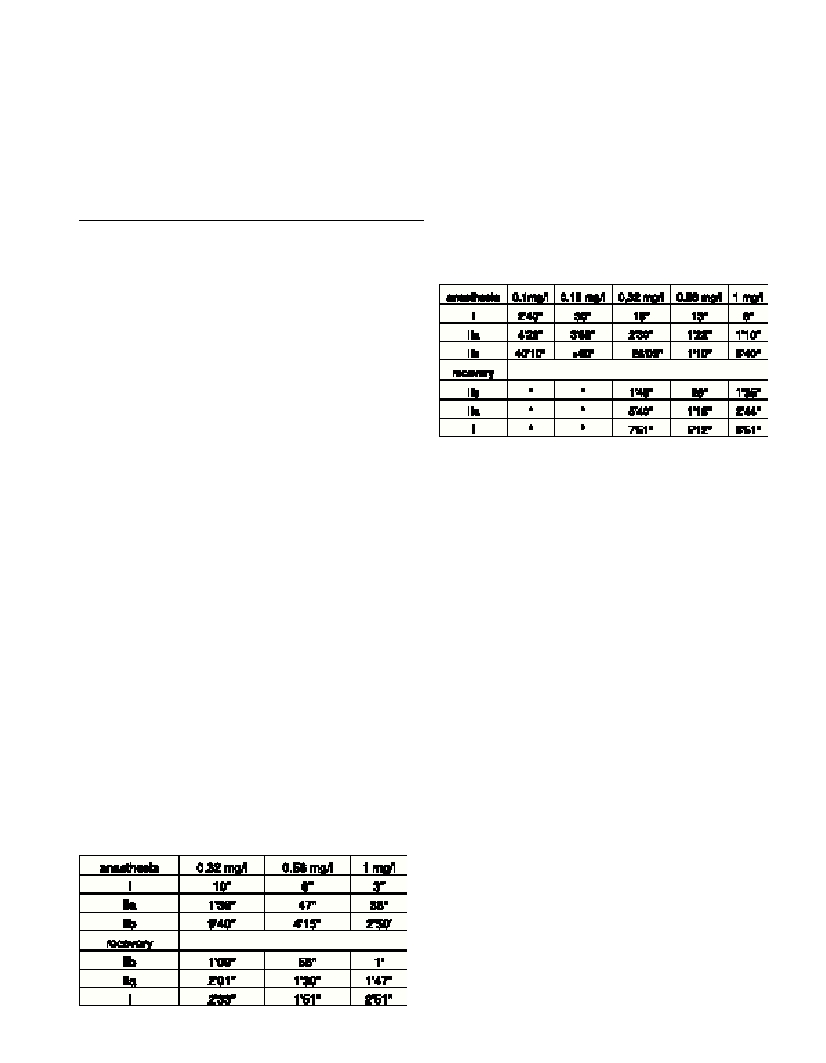COMPARATIVE EFFECTIVENESS OF 2-PHENOXYETHANOL AND PROPISCIN AS ANESTHETICS
FOR LARVAL SEA BASS DICENTRARCHUS LABRAXL.
Ivona Mladineo
Institute of Oceanography and Fisheries, Split, Croatia - mladineo@izor.hr
Abstract
The comparative effectiveness of 2-phenoxyethanol and Propiscin as anesthetic was studied for larval sea bass (Dicentrarchus labrax L.).
Both anesthetics showed good hypnotic characteristics. However Propiscin induced slower anesthesia than of 2-phenoxyethanol at the
same concentrations. The most suitable concentration for anesthesia was 0.56 ml/l for Propiscin and 0.32 ml/l for 2-phenoxyethanol. Based
on the results of the experiments it can be concluded that the 2-phenoxyethanol is more suitable for larval sea bass anesthesia.
Keywords: Larval sea bass, 2-phenoxyethanol, Propiscin, anesthesia
Rapp. Comm. int. Mer Médit., 37,2004
402
Introduction
2-Phenoxyethanol or Ethylene Glycol Monophenyl Ether (EGPE)
is used for anesthesia in freshwater fisheries for routine work, because
of its fast effect, good and quick recovery time provided that the expo-
sition to the drug is not very long (1, 2).
The other widely used and effective anesthetic in freshwater fish
culture is Propiscin (IRS, Polland), containing 0.2% stabilized solu-
tion of etomidate, which is a non-barbiturate hypnotic. It is adequate,
especially for freshwater fishes, because of its high solubility in water,
effectiveness and safety (3, 4, 5).
The purpose of the study was to examine the effectiveness of men-
tioned anesthetics, which are widely and successfully used in fresh-
water culture, for possible applications in sea bass’rearing.
Materials and methods
Three hundred larval sea bass (Dicentrarchus labraxL.), weighting
0.39 ±0.1 g, were collected from a nearby hatchery and left for an
acclimatization period of 14 days in 500-l polyvinyl pots with a circu-
lating system.
The onset of different phases of anesthetic and recovery was meas-
ured in seconds and minutes according to (6). Phase I is characterized
by physiological position, increased activity, restlessness and irregu-
lar respiratory motion; phase IIa with decreased activity, tilting on the
?ank, slower and deeper respiratory motion; phase IIb with ?ank posi-
tion, loss of motility and deep retarding respiration and phase III with
?ank position and blocked respiratory motions.
Results and discussion
Duration of specific anesthesia and recovery phases for different
concentrations of 2-phenoxyethanol and Propiscin are shown in
Tables 1 and 2. Both anesthetics showed good hypnotic characteris-
tics. Propiscin did not show the same capacity to induce faster anes-
thesia with slower recovery period than 2-phenoxyethanol, as suggest-
ed in earlier experiments with freshwater fishes (6). Propiscin concen-
tration most suitable for anesthesia was 0.56 ml/l. In the case of
2-phenoxyethanol, the concentration of 0.32 mg/l slowest induced the
IIb phase of anesthesia, but the excitation stage was not sharp and fast.
The recovery period at same concentration was the longest, but most
safe and unstressful for the fish in means that awaking was smooth
without erratic movements, thus pointing this concentration to be the
safest for the larvae.
It can be concluded that the 2-phenoxyethanol is more suitable than
Propiscin for larval sea bass anesthesia and appropriate anesthesia
phases are achieved much faster than with Propiscin.
References
1-Idler D.R., McBride J.R., Jonas R.E.E., and Tomlinson N., 1961.
Olfactory perception in migrating salmon. Cannadian J. Biochem.
Physiol., 39: 1575-1584.
2-Sehdev H.S., McBride J.R., and Fagerland U.H.M., 1963. 2-
Phenoxyethanol as a general anaesthetic for sockeye salmon. J. Fish. Res.
Bd. Canada., 20(6): 1435-1440.
3-Amend D.F., Goven B., and Elliot D.G., 1982. Etomidate: effective
dosages for a new fish anaesthetic. Trans. Am. Fish. Soc., 111: 337-341.
4-Plumb J.A., Schwedler T.E., and Limsuwan C., 1983. Experimental
anaesthesia of three species of freshwater fish with etomidae. Prog. Fish-
Cult., 45(1): 30-33.
5-Kouril J., Stupka Z., Hamácková J., and Lepicková A.,2001. The
Preliminary Results of Effect of Three Anaestetics on Various Fish Species
(in Czech). Pp. 131-136. In: Kolárova J.et al.(ed.): Ochrana zdravi ryb.
VÚRH JU Vodnany..
6-Hamácková J., Sedova M.A., Pjanova S.V., and Lepicová, A.,2001.
The effect of 2-phenoxyethanol, clove oil and Propiscin anaesthetics on
perch (Perca ?uviatilis) in relation to water temperature. Czech. J. Anim.
Sci., 46: 469-473.
Table 1. Duration of anasthesia and recovery phases of 2-phe-
noxyethanol at different concentrations.
Table 2. Duration of anasthesia and recovery phases of Propiscin at dif-
ferent concentrations.The asterix (*) is for concentrations that had to
long IIb phase of anaesthesia.

